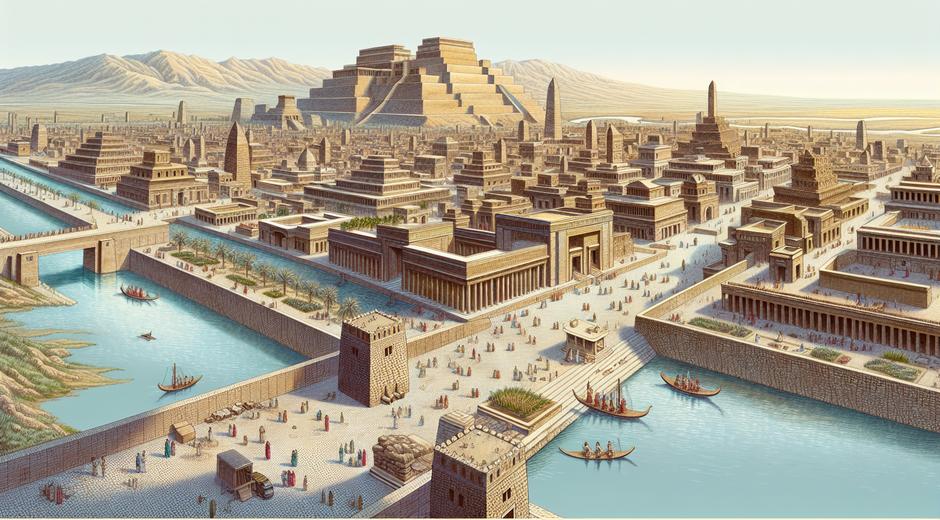Babylon: The Ancient City That Shaped Civilization
Babylon evokes images of towering walls, majestic palaces, and legendary gardens. As a center of power in ancient Mesopotamia, Babylon left a lasting imprint on law, architecture, literature, and religion. This article explores the rise and fall of Babylon, its cultural achievements, the rulers who shaped its destiny, and the legacy that continues to influence our modern world. For readers who want to explore more history articles across eras and regions visit chronostual.com for a wide range of historical perspectives.
Origins and Geographic Importance
Babylon arose on the fertile plain between the Tigris and Euphrates rivers. Its strategic location made it a hub for trade and communication between Anatolia, the Iranian plateau, and the Arabian lands. The city first gained prominence in the early second millennium BC under Amorite rulers. Over centuries Babylon grew from a city state into a dynastic capital and later into the heart of empires that controlled large swaths of the ancient Near East.
The Age of Hammurabi and the Law Code
One of the most influential figures in Babylonian history was Hammurabi. He reigned in the eighteenth century BC and is best known for a law code that sought to regulate social order. The code covers a wide range of topics such as property rights, family relations, labor obligations, and criminal penalties. Inscribed on a tall stone stele, Hammurabi code is not only a legal document but also a window into the values and daily life of ancient Mesopotamia. The idea that a ruler should publicly announce laws to ensure justice had far reaching consequences for later civilizations.
Nebuchadnezzar II and Babylonian Splendor
Nebuchadnezzar II presided over a revival of Babylonian grandeur in the seventh and sixth centuries BC. Under his rule the city underwent massive building campaigns. Walls and gates were strengthened, palaces were expanded, and grand processional ways were laid out. Nebuchadnezzar also features in biblical narratives which contributed to a complex reputation that blends historical fact with cultural memory.
The Hanging Gardens and Architectural Innovation
The Hanging Gardens are among the most enduring legends associated with Babylon. Described as a terraced garden with exotic trees and flowing water, they symbolize human ingenuity in transforming an arid landscape into a lush oasis. While some scholars debate whether the gardens existed in the precise form described by later writers, the accounts reflect Babylonian skill in irrigation and urban design. In addition to gardens, Babylonians pioneered architectural techniques using baked brick and bitumen that allowed construction of monumental structures capable of surviving the harsh regional climate.
Religion, Astronomy, and Learning
Religion played a central role in Babylonian life. Temples and ziggurats stood at the heart of cities as places of worship and centers of economic activity. Babylonian priests also contributed significantly to astronomy and mathematics. They observed planetary movements, recorded eclipses, and developed sophisticated systems of calculation. These observations and techniques influenced later Hellenistic and Islamic scholars and contributed to the long chain of scientific knowledge that reached Europe in the medieval era.
Language and Literature
The Babylonian version of Akkadian became a lingua franca for diplomacy and scholarship across the region. Literature produced in Babylon includes myths, epics, hymns, and legal texts. The Epic of Gilgamesh though older in origin was preserved in Babylonian literary tradition and transmitted across generations. Babylonian scribes trained in temple schools created a corpus of cuneiform tablets that preserves religious ritual, medical prescriptions, and administrative records. These texts offer detailed insights into economic life, belief systems, and the social structure of ancient Mesopotamian societies.
Conquests and Changing Empires
Babylon experienced cycles of conquest and revival. It fell under the sway of Assyrian kings before emerging again as an independent power. Later it became the core of the Neo Babylonian Empire then succumbed to Persian rule under Cyrus the Great. Each transition brought cultural and administrative changes but also continuity in many local practices. The persisting importance of Babylon as a cultural center ensured that even after political power shifted the city remained significant in trade and religion.
Archaeology and Rediscovery
Modern archaeology has uncovered extensive remains that help reconstruct Babylonian life. Excavations have revealed city walls, palaces, and numerous cuneiform tablets. Artifacts recovered by archaeologists provide physical evidence of the technologies, craft skills, and artistic tastes of the period. Conservation and study of these finds continues to refine our understanding of how Babylon worked as an urban environment and as a symbol of imperial authority.
Preservation Challenges and the Modern Narrative
Today the ruins of Babylon face environmental erosion and threats related to urban development. Efforts by international teams aim to document and preserve what remains but practical challenges persist. The story of Babylon remains alive in museums, academic research, literature, and popular culture. It serves as a reminder of the fragility of heritage and the importance of stewardship for future generations.
Babylon in Cultural Memory
Babylon resonates in language and imagination as a symbol of both human achievement and moral caution. References in religious texts, classical literature, and contemporary media have kept the name prominent. Scholars and enthusiasts continue to debate legendary elements such as the exact form of the Hanging Gardens and the daily realities behind biblical episodes. This ongoing dialogue enriches our appreciation for a city that influenced law, architecture, science, and storytelling.
Visiting Babylon Today
Visiting the site of Babylon offers a tangible connection to ancient history. Travelers can view traces of the famed walls and some reconstructed elements that give a sense of the city layout. Guided tours and museum collections in the region provide context for the ruins and present artifacts recovered by archaeologists. Those who explore Babylon in person often find it helps transform abstract names into concrete places shaped by generations of human activity.
Why Babylon Still Matters
Babylon matters because it encapsulates a key chapter in the development of civilization. From codifying laws to advancing astronomical knowledge, from building monumental architecture to shaping religious thought, the city played multiple roles that echo through time. Academic research and public interest keep uncovering new facets of Babylonian life. For families and educators seeking accessible materials that connect ancient history to learning at home the content at CoolParentingTips.com offers creative ideas for bringing the past into the present.
Conclusion
Babylon remains one of the most evocative names from antiquity. Its history is a tapestry of innovation, faith, conquest, and cultural exchange. Studying Babylon helps us understand how human societies organize power, create enduring laws, and imagine the world around them. As archaeological work and scholarship progress we will continue to gain a clearer picture of how this ancient city shaped the course of history and why its legacy still inspires curiosity today.















